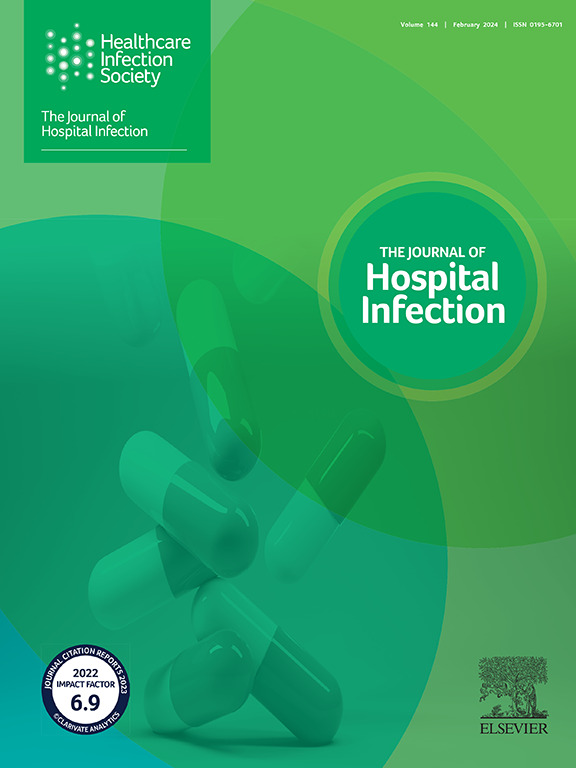抗菌织物擦洗可以防止病原体在擦洗上增殖。
IF 3.1
3区 医学
Q1 INFECTIOUS DISEASES
引用次数: 0
摘要
背景:美国医院每年发生约170万例医疗相关感染(HAIs)。卫生保健提供者的衣服通常会在照顾病人时被污染,并可能成为传播给病人的病原体来源。先前的研究表明,经抗菌处理的纺织品/服装显示出对病原体的活性;然而,研究受到样本量、工作环境和缺乏盲法的限制。目的:我们的目的是确定注册护士(RNs)和患者护理技术人员(pct)在内科/外科病房使用抗菌织物擦洗的效果,以减少擦洗的病原体获取,患者因素与病原体获取之间的关系,以及按擦洗类型划分的满意度/不良事件。方法:采用双盲、三臂、随机对照、交叉设计试验,对某非营利性医院248个床位的内科/外科病房的127名受试者(事后功效=0.994)进行研究。研究对象为连续3次轮班12小时的注册护士和住院医师。将两种实验擦洗剂(红色- 1-锌-吡硫酮和蓝色- 2-锌-吡硫酮/流体屏障)与黑色- 3-未经处理的对照进行评估。结果:所有拭子位置的病原体获取没有差异,而蓝色2号的病原体增殖率明显低于红色1号(结论:吡啶硫酮锌/亲水性氟碳树脂处理的织物擦洗比单独处理或对照擦洗的病原体增殖率低。在卫生保健环境中引入这种擦布可以减少病原体从卫生保健工作者的衣服向患者和环境的传播,并降低HAI发生率。本文章由计算机程序翻译,如有差异,请以英文原文为准。
Antimicrobial-treated fabric scrubs can prevent pathogen proliferation on scrubs
Background
Approximately 1.7 million healthcare-associated infections (HAIs) occur annually in US hospitals. The clothing of healthcare providers routinely becomes contaminated while caring for patients, and may serve as a pathogen source for transmission to patients. Previous studies indicated that antimicrobial-treated textiles/clothing demonstrated activity against pathogens; however, studies were limited by sample size, work setting and the lack of blinding.
Aim
To determine the efficacy of antimicrobial-treated fabric scrubs worn by registered nurses (RNs) and patient care technicians (PCTs) on medical/surgical wards to decrease the pathogen acquisition of scrubs, relationships between patient factors and pathogen acquisition, and satisfaction/adverse events by scrub type.
Methods
A double-blinded, three-arm, randomized, controlled trial with a crossover design was conducted with 127 subjects (post-hoc power=0.994) on medical/surgical wards in a full service, 248-bed, non-profit hospital. Subjects were RNs and PCTs providing patient care over three consecutive 12-h shifts. Two experimental scrubs [red-#1 (treated with zinc pyrithione alone) and blue-#2 (treated with zinc pyrithione plus hydrophilic fluorocarbon resin)] were evaluated against untreated control scrubs (black-#3).
Findings
Pathogen acquisition did not differ between swab locations, while pathogen proliferation was significantly lower for the blue-#2 scrubs compared with the red-#1 (P<0.001) and black-#3 (P<0.001) scrubs. There were no significant relationships between patient interactions, infections, care activities/characteristics and pathogen acquisition. One product-related adverse event was reported (red-#1 scrubs, headache). Scrub satisfaction was high.
Conclusion
Scrubs treated with zinc pyrithione plus hydrophilic fluorocarbon resin demonstrated lower pathogen proliferation compared with scrubs treated with zinc pyrithione alone or control scrubs. Introducing such scrubs in the healthcare setting may reduce the transmission of pathogens from the clothing of healthcare workers to patients and the environment, and reduce HAI rates.
求助全文
通过发布文献求助,成功后即可免费获取论文全文。
去求助
来源期刊

Journal of Hospital Infection
医学-传染病学
CiteScore
12.70
自引率
5.80%
发文量
271
审稿时长
19 days
期刊介绍:
The Journal of Hospital Infection is the editorially independent scientific publication of the Healthcare Infection Society. The aim of the Journal is to publish high quality research and information relating to infection prevention and control that is relevant to an international audience.
The Journal welcomes submissions that relate to all aspects of infection prevention and control in healthcare settings. This includes submissions that:
provide new insight into the epidemiology, surveillance, or prevention and control of healthcare-associated infections and antimicrobial resistance in healthcare settings;
provide new insight into cleaning, disinfection and decontamination;
provide new insight into the design of healthcare premises;
describe novel aspects of outbreaks of infection;
throw light on techniques for effective antimicrobial stewardship;
describe novel techniques (laboratory-based or point of care) for the detection of infection or antimicrobial resistance in the healthcare setting, particularly if these can be used to facilitate infection prevention and control;
improve understanding of the motivations of safe healthcare behaviour, or describe techniques for achieving behavioural and cultural change;
improve understanding of the use of IT systems in infection surveillance and prevention and control.
 求助内容:
求助内容: 应助结果提醒方式:
应助结果提醒方式:


